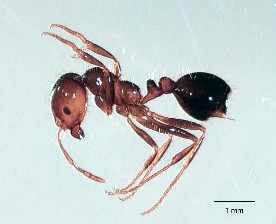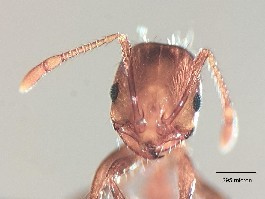Solenopsis invicta
Solenopsis invicta

Classification
| Family: | Formicidae |
| Subfamily: | Myrmicinae |
| Tribe: | |
| Genus: | Solenopsis |
| Species: | invicta |
The red imported fire ant is considered to be the worst ant pest in the world. It has the potential to become a significant environmental, economic and human health hazard should it ever become established here.
These tiny but aggressive, reddish-brown ants have a painful sting. Symptoms include intense burning and itching, which usually subsides over the first hour, but which may return over the next few days. A blister forms at the site of the sting within 5 to 24 hours. This is followed by the formation of a white pustule. The pustule should be left intact (try not to scratch!) as this risks infection.
Identification
 Females of this genus are readily identifiable by: a 10-segmented antenna with a two-segmented club; an absence of spines on the propodeum; and the front margin of the clypeus just above the mandibles with a central elongate hair or seta (Shattuck 1999).
Females of this genus are readily identifiable by: a 10-segmented antenna with a two-segmented club; an absence of spines on the propodeum; and the front margin of the clypeus just above the mandibles with a central elongate hair or seta (Shattuck 1999).
The fire ant has a very distinctive nest — they often form mounds of fine granular soil with an entrance to the side. Mounds are highly variable in size, but in some cases can reach nearly a metre in height and width. Size and shape depend on soil type and vegetation. If the nest is disturbed workers will swarm out of the nest to defend the colony.
New Zealand Incursions
In March 2001, a gardener found a red imported fire ant nest at Auckland Airport. The nest was destroyed and a major search of the area found no more nests.
A further incursion of red imported fire ants was found at the Port of Napier in February 2004. Approximately 200 workers were found in attractant bait traps during surveillance activity undertaken as part of the Ministry of Agriculture and Forestry national invasive ant programme. As there is a possibility that reproductive castes may have flown from the area before the incursion was found ongoing surveillance is being carried out to detect any nests.
Due to concern over the possibility of further incursions of fire ants into New Zealand MAF Biosecurity New Zealand has carried out an assessment of the risk of red imported fire ants arriving into New Zealand via the importation of goods and arrival of craft from Australia, the Caribbean, South America, and the USA. Download report ![]() (1.2 MB)
(1.2 MB)
References
Shattuck, S.O. 1999: Australian ants: their biology and identification. Monographs on invertebrate taxonomy, Vol. 3. Collingwood, Australia, CSIRO Publishing.
